At the beginning of the 16th century, the Portuguese built a fortified town on the western coast of North Africa, that is, the first fortification on the site of what would become the city later named Mazagan, but they expanded that initial citadel into a larger fort with high walls in 1541.
The city remained in Portuguese hands until 1769, when it became part of Morocco. Since all the previous inhabitants of the city (the Portuguese) had left, the place was abandoned for a while, but the city that later arose there was named El Jadida, which fittingly means – The New.
Thus the Moroccans gained their “new” city, while the Portuguese retained the pride that the walls of the former Mazagan on the Atlantic coast were included among the Seven Wonders of Portuguese Origin in the World. Namely, Mazagan is the best-preserved Portuguese fortification in Morocco and, moreover, Portuguese fortifications around the world have usually been significantly altered over time, which is not the case here. Be as it may, both sides can be proud that this old city is inscribed on the UNESCO World Heritage List.
Mazagan was very important to the Portuguese because it represented a significant point in western Africa on the route to India and through what has survived here, one can see the mutual influence of European and local (Moroccan) cultures, which is reflected in urban planning as well as in architecture.
This rather large fortification, which is roughly rectangular in shape (approximately 320 x 230 m), with its walls and bastions, represents an example of Renaissance military architecture in which the Portuguese approach adapted to the use of firearms was applied. Within the walls, there was an entire town, while the most important structures that have survived to this day are the cistern and the Church of the Assumption. It was the church that was the first significant building I encountered when I passed through the gate leading into the fortifications.
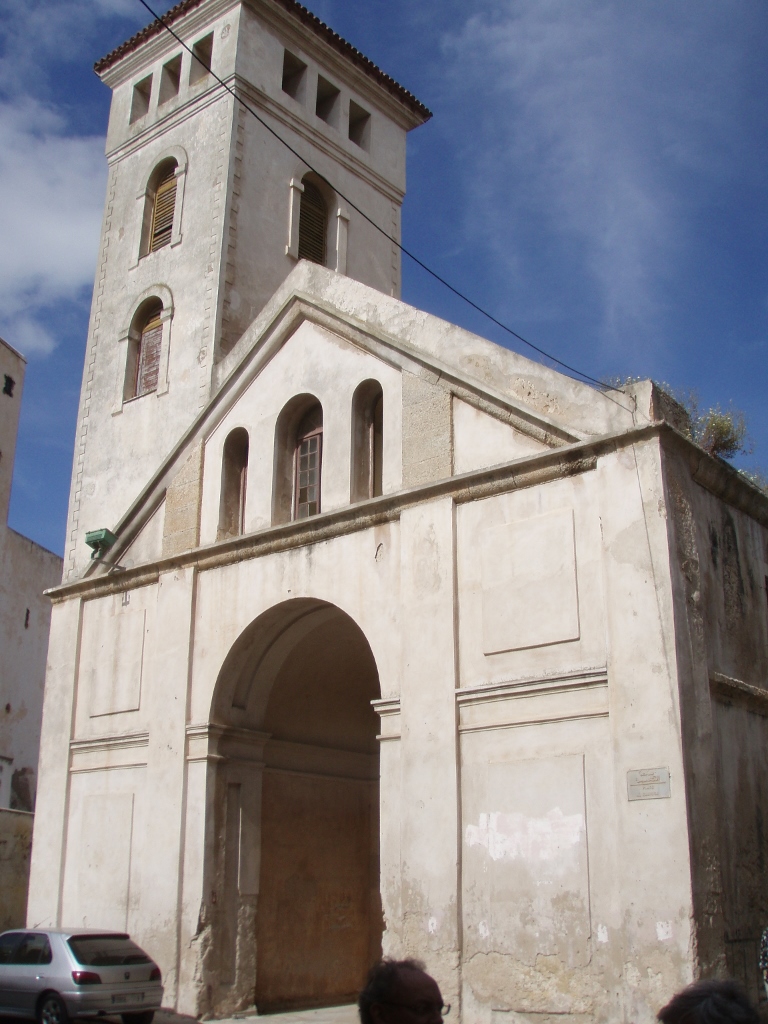 El Jadida, a detail
El Jadida, a detail
Although the church building still stands here, it no longer functions as a church; it was taken over long ago and is now used for other, secular purposes. From what I’ve read, today it serves as a kind of a theatre hall for the local community.
And continuing from the gate that leads into the town, next to the church, runs the main street within the fortification. A bit further on is the cistern, but I decided to go first to the walls and begin my tour from there.
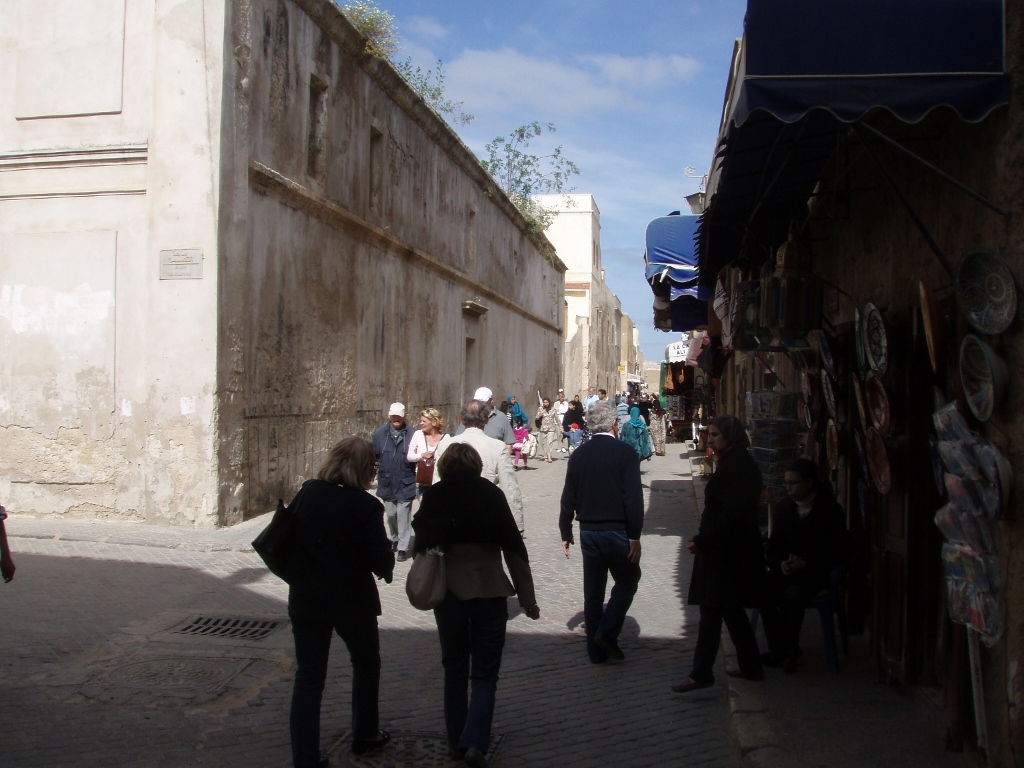 El Jadida, a detail
El Jadida, a detail
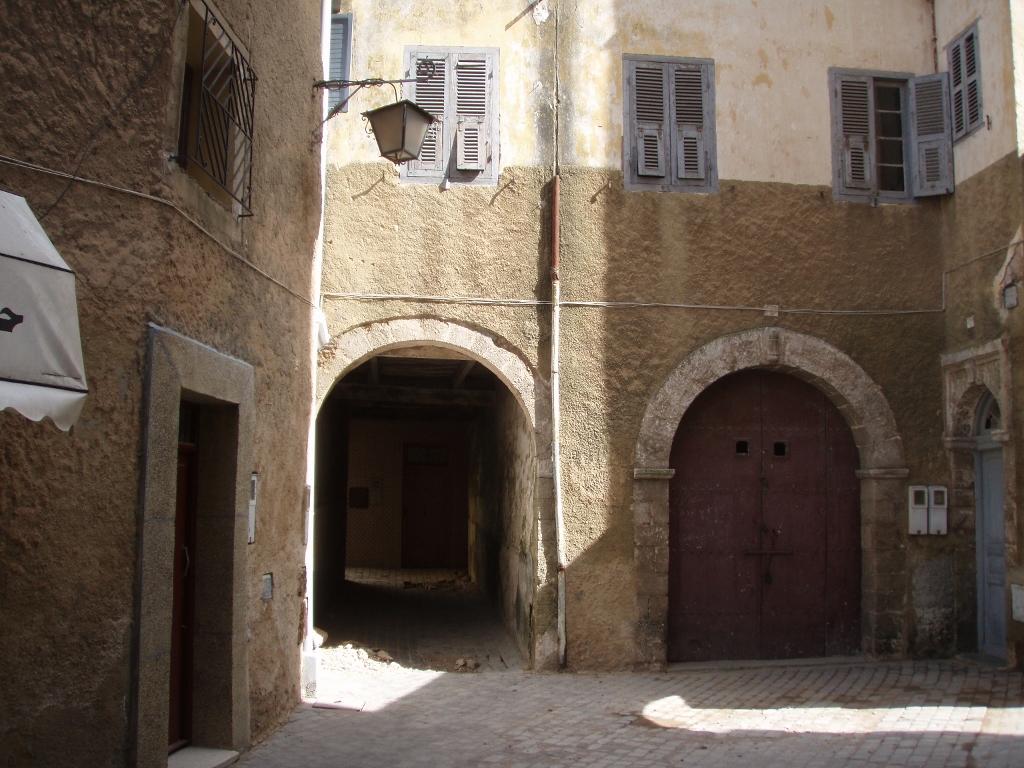 El Jadida, a detail
El Jadida, a detail
I made my way to the southern walls of the former Mazagan and the south-western bastion, where several old cannons are lined up in order to give everything a more authentic feel.
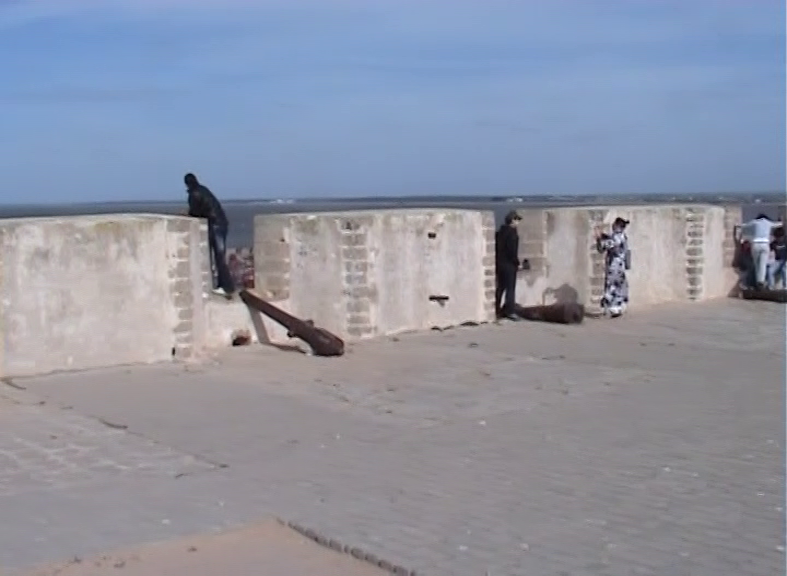 El Jadida, a detail
El Jadida, a detail
As it can be seen from the following photo, although there is a wide path along the walls of the fortification, people (myself included) tend to enjoy walking right on top of the ramparts.
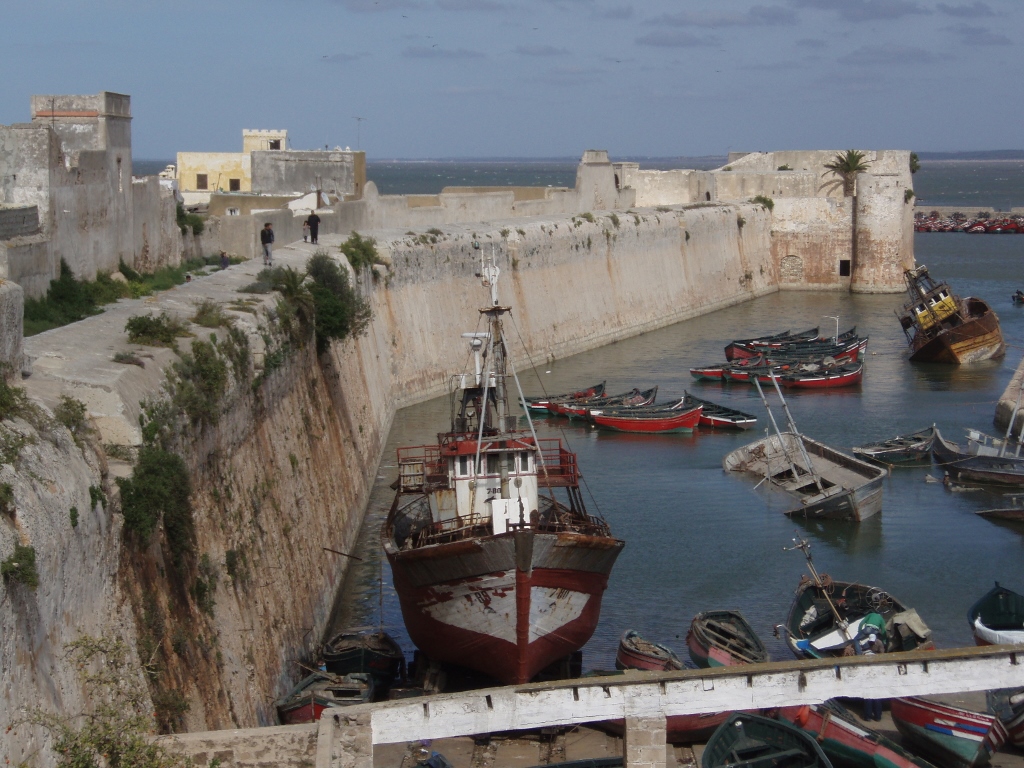 El Jadida, a detail
El Jadida, a detail
At some point, however, I came down from the ramparts and continued along the path, which led me to the eastern walls. What might seem strange at first glance, considering that the Atlantic Ocean lies west of Morocco, is that here it appears as though the open sea stretches towards the east (more precisely, towards the east-northeast). On clear days, one can likely see more clearly that there is land at the end of this “open sea.” This all becomes clearer when looking at a map, where it’s evident that El Jadida is located on a peninsula extending northwards, while Mazagan was built on its eastern side, facing the Moroccan coast, which in this area runs along a southwest-northeast line.
On this day, what stood out most were the many colourful boats anchored in the harbour, protected from the powerful Atlantic Ocean.
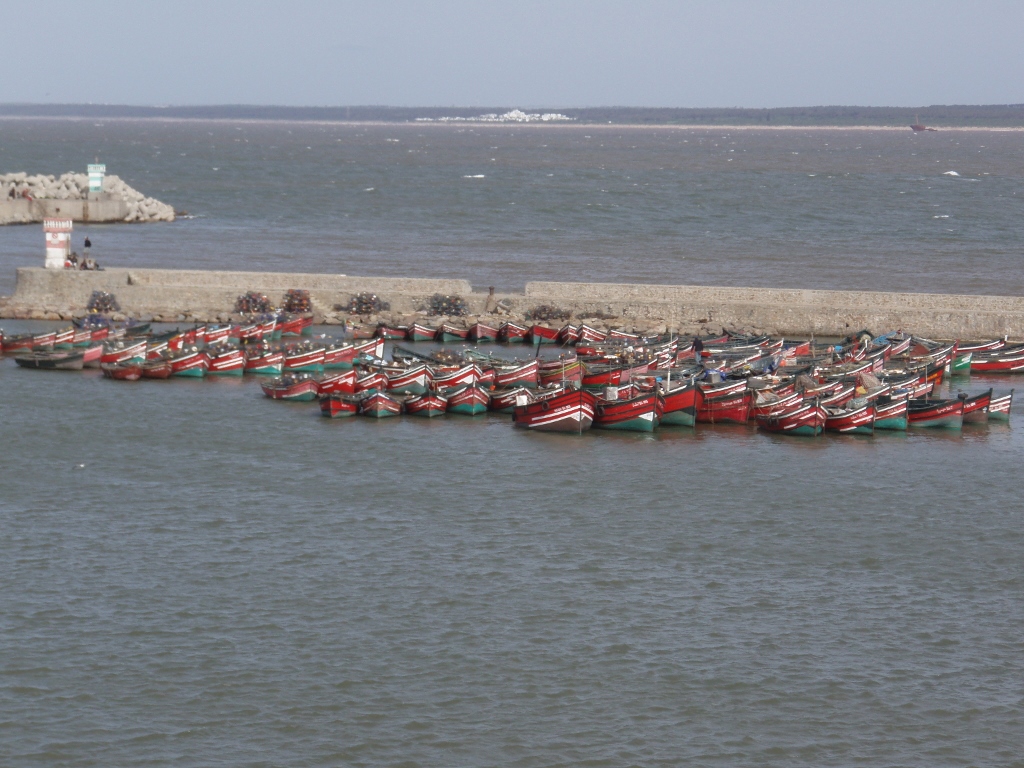 El Jadida, a detail
El Jadida, a detail
Here I also reached the south-eastern bastion, where there are more old cannons lined up, but from there you can also see other parts of the fortification and the sheltered section of the harbour.
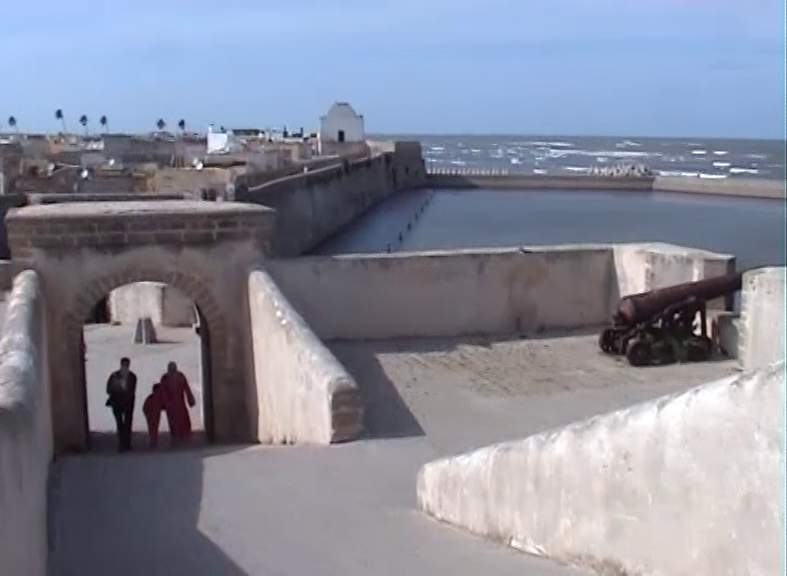 El Jadida, a detail
El Jadida, a detail
In the next photo, parts of the fortification can be seen even more clearly, and soon after, I passed through the gate visible in the foreground of the image below.
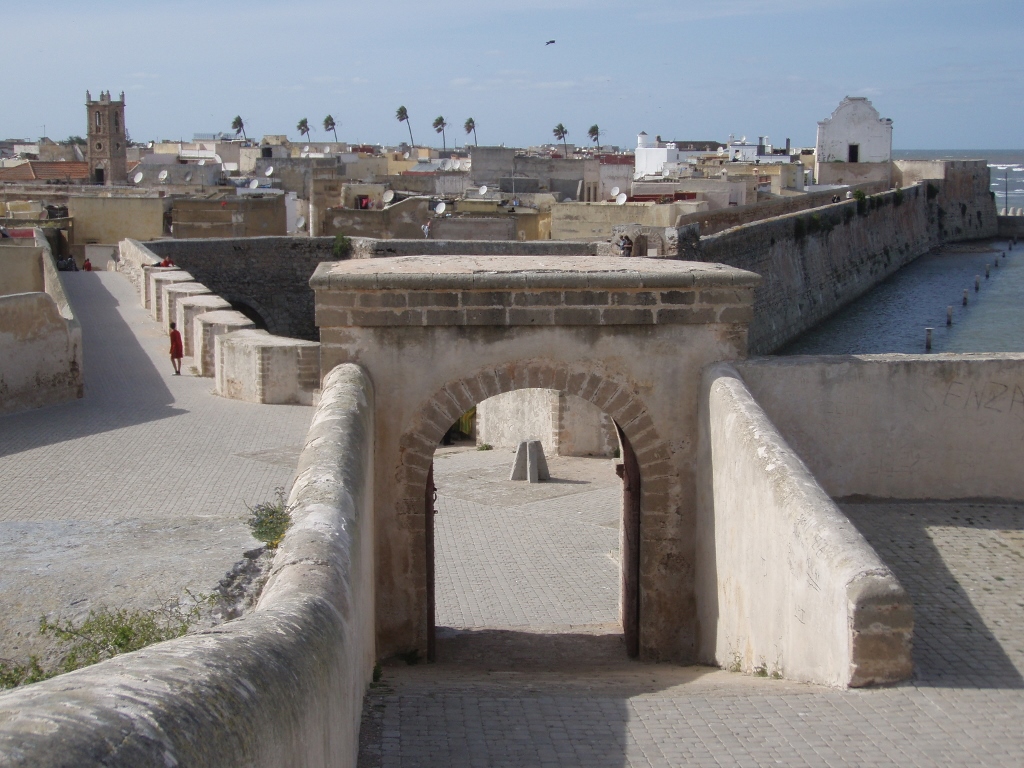 El Jadida, a detail
El Jadida, a detail
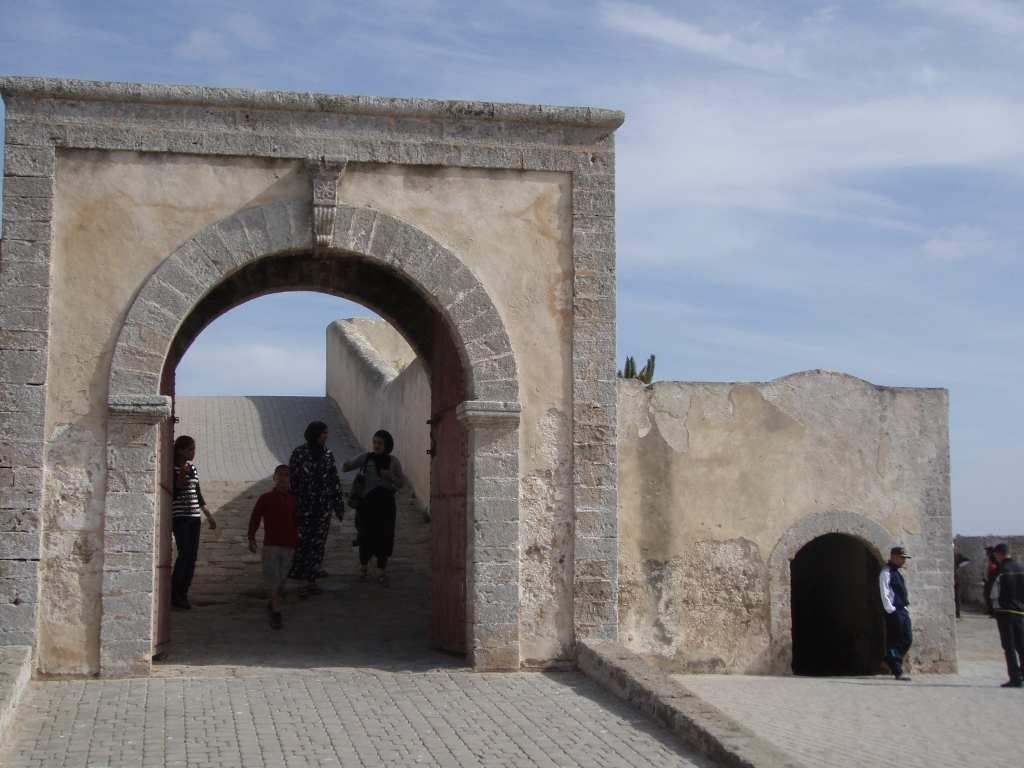 El Jadida, a detail
El Jadida, a detail
After passing through this gate, you come to a kind of “indentation” in the eastern walls, where the “Sea Portal” is located.
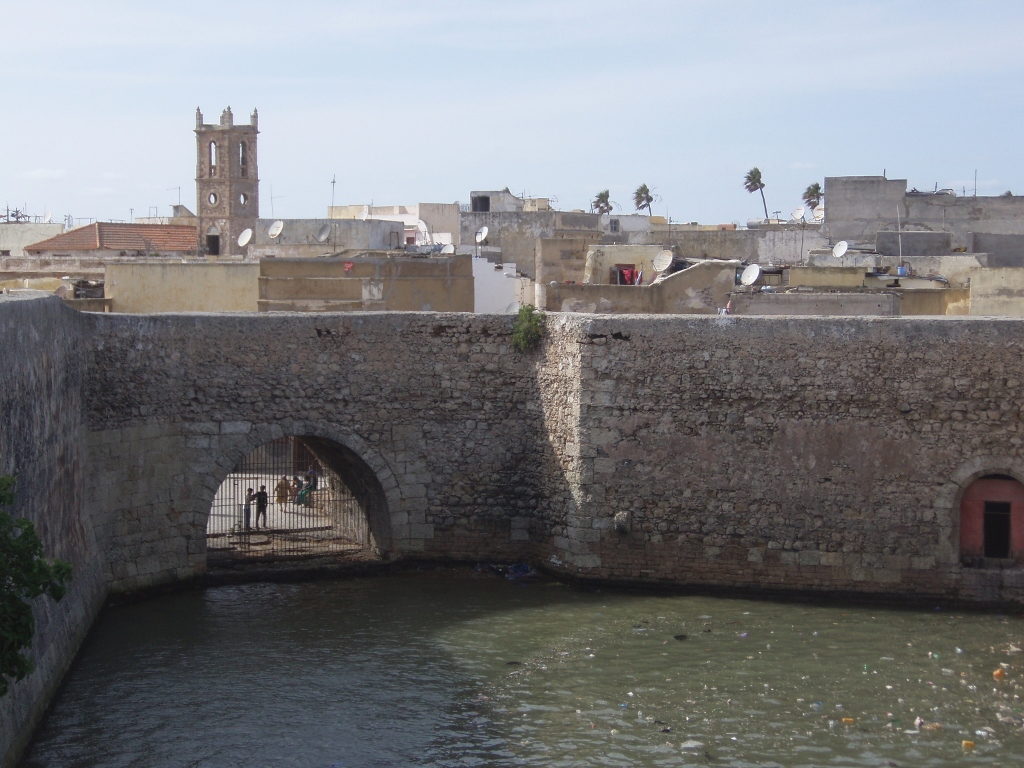 El Jadida, a detail
El Jadida, a detail
A bit further on is the north-eastern corner of the fortification and right next to it is the Bensimon Synagogue, built in 1926.
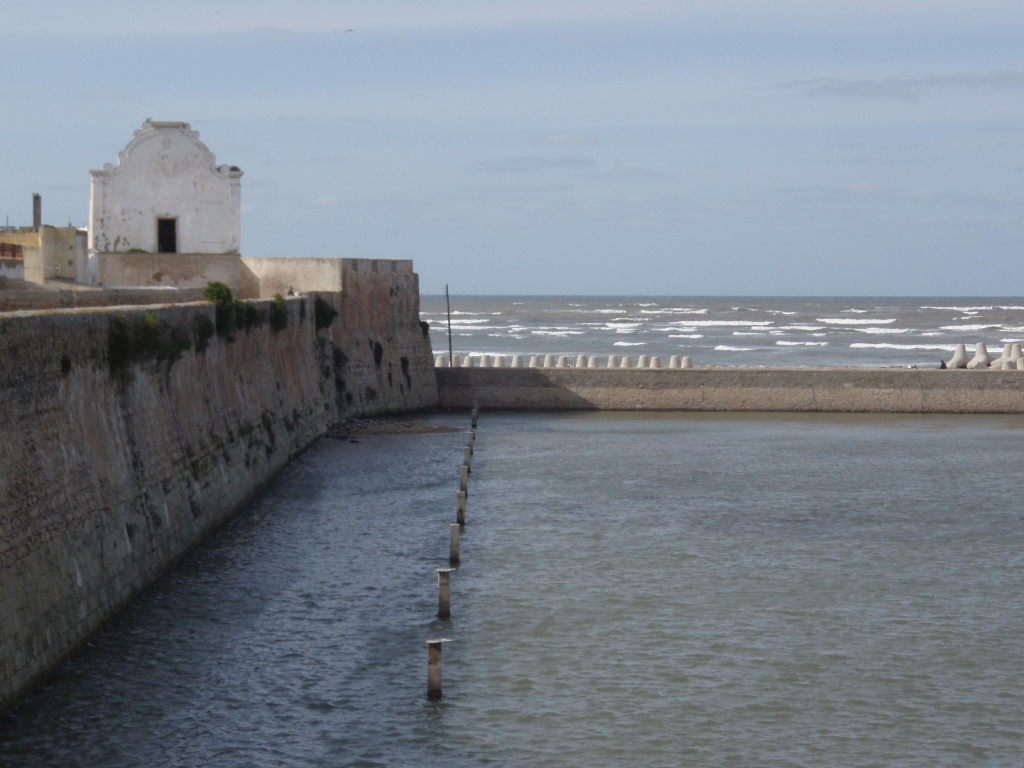 El Jadida, a detail
El Jadida, a detail
As I’ve already mentioned, after the Portuguese left, Mazagan was abandoned for a time, but the fortification came back to life in the mid-19th century. The new city of El Jadida continued to grow and develop into an important trade centre, as well as a multicultural society, with Muslims, Jews and Christians all living there.
As I walked further along the walls of the former fortification, I was able to see its various parts from different angles.
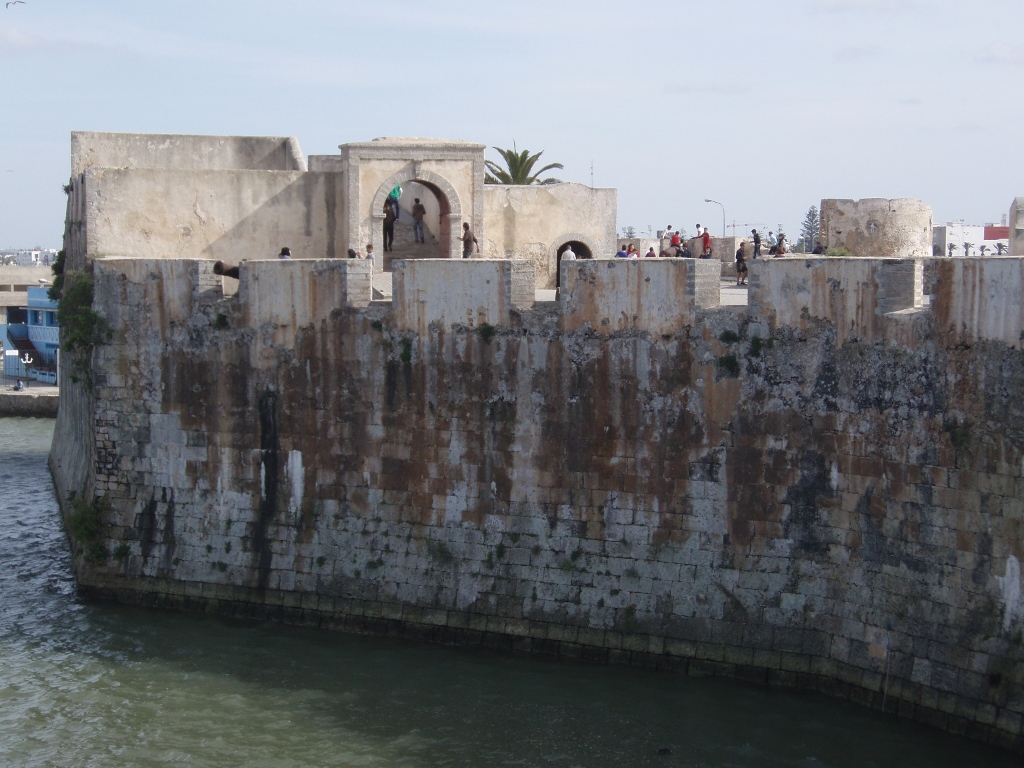 El Jadida, a detail
El Jadida, a detail
At one spot, I found it particularly interesting that an active chimney stood right in the middle of the walkway along the walls. As I later learned, it belongs to a public bakery, that is, an oven shared by members of the local community – something quite common in Morocco. Although people have ovens in their homes, large loaves of bread and similar baked goods are usually baked in these communal/public ovens, where there is someone responsible for the baking.
 El Jadida, a detail
El Jadida, a detail
Soon I arrived at the Bensimon Synagogue.
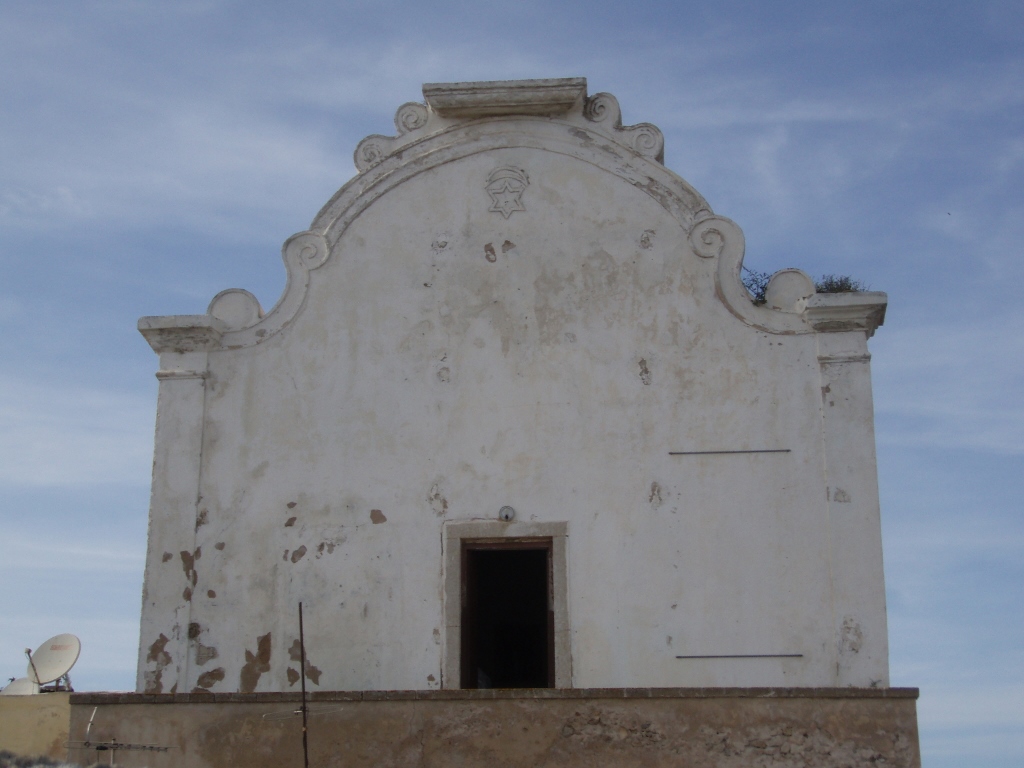 El Jadida, a detail
El Jadida, a detail
Walking along the northern walls of the fortification, I could also see the minaret of the Great Mosque.
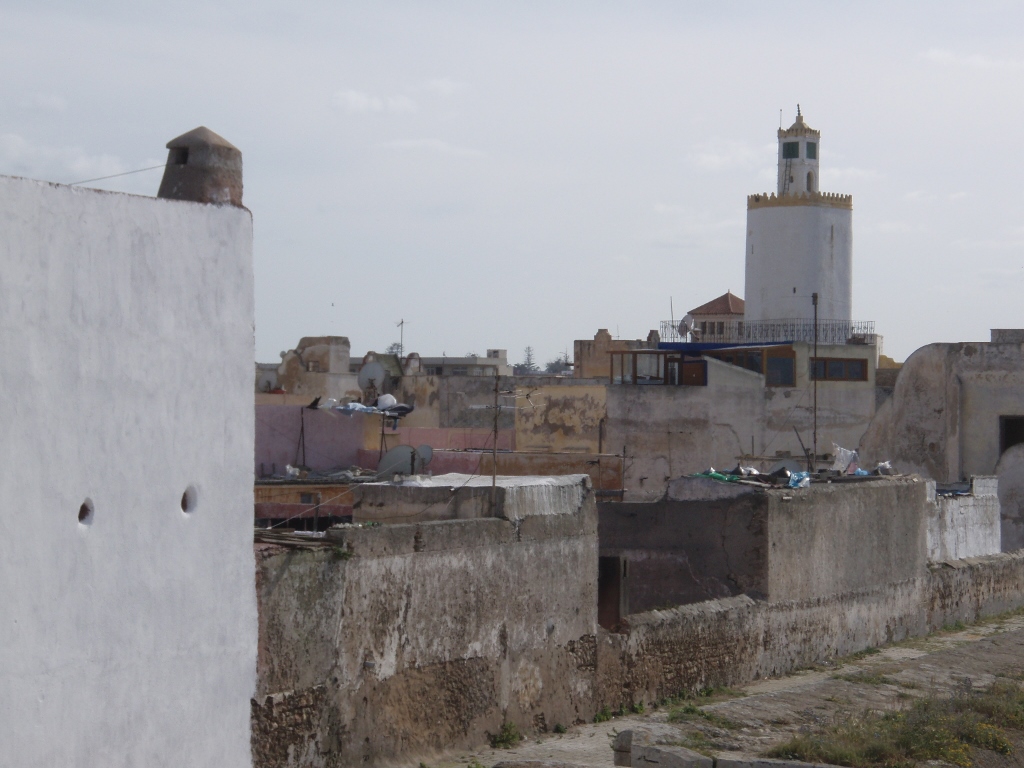 El Jadida, a detail
El Jadida, a detail
But I have to admit that, at this moment, I was far more intrigued by what I could see down on the street. It was the most entertaining football match I had ever seen in my life.
Here are a couple of photos from the same “match” and in one of them you can even see the goal posts, marked by two stones, in the middle of the street. It was incredibly entertaining!
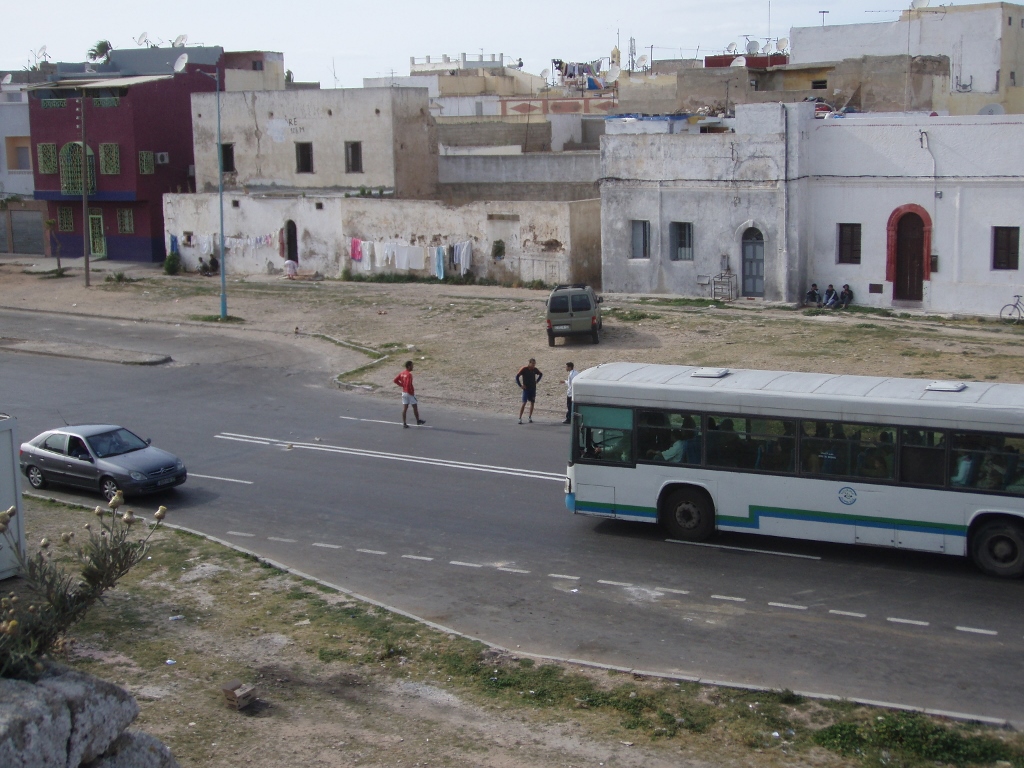 El Jadida, a detail
El Jadida, a detail
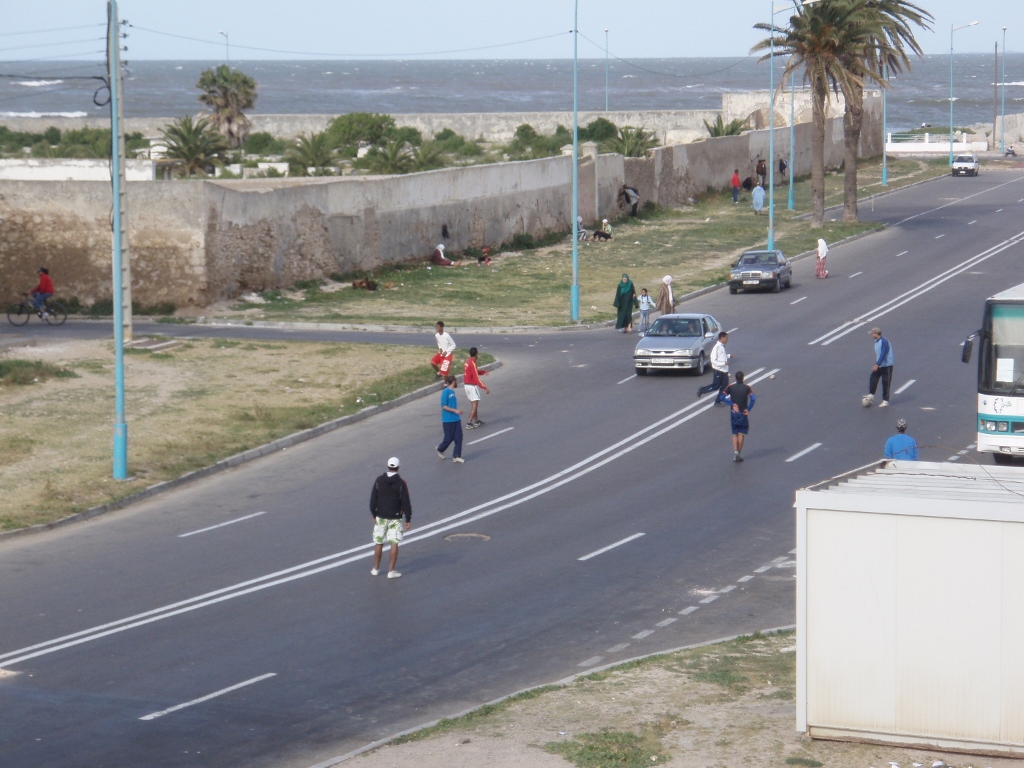 El Jadida, a detail
El Jadida, a detail
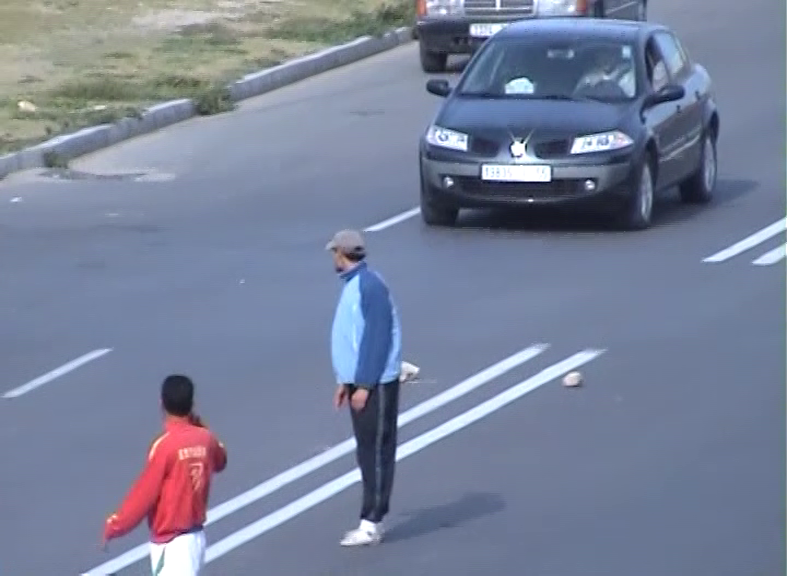 El Jadida, a detail
El Jadida, a detail
Continuing my tour of the fortification in El Jadida, I left the walls and set off through the streets of the Portuguese City, as this fortification is often called. I really enjoyed this part, especially because the wind, particularly while I was on the ramparts, was so strong that it was almost unpleasant.
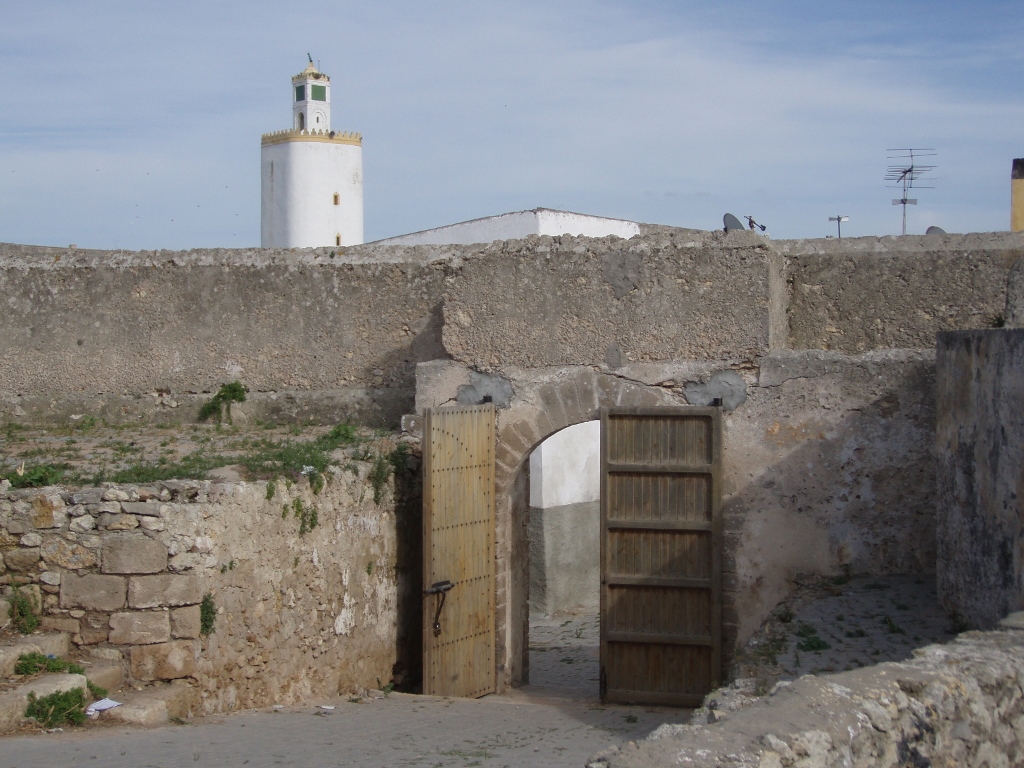 El Jadida, a detail
El Jadida, a detail
This entire area is actually not very large and I soon found myself in a street where, in addition to some impressive portals, I once again saw the Church of the Assumption.
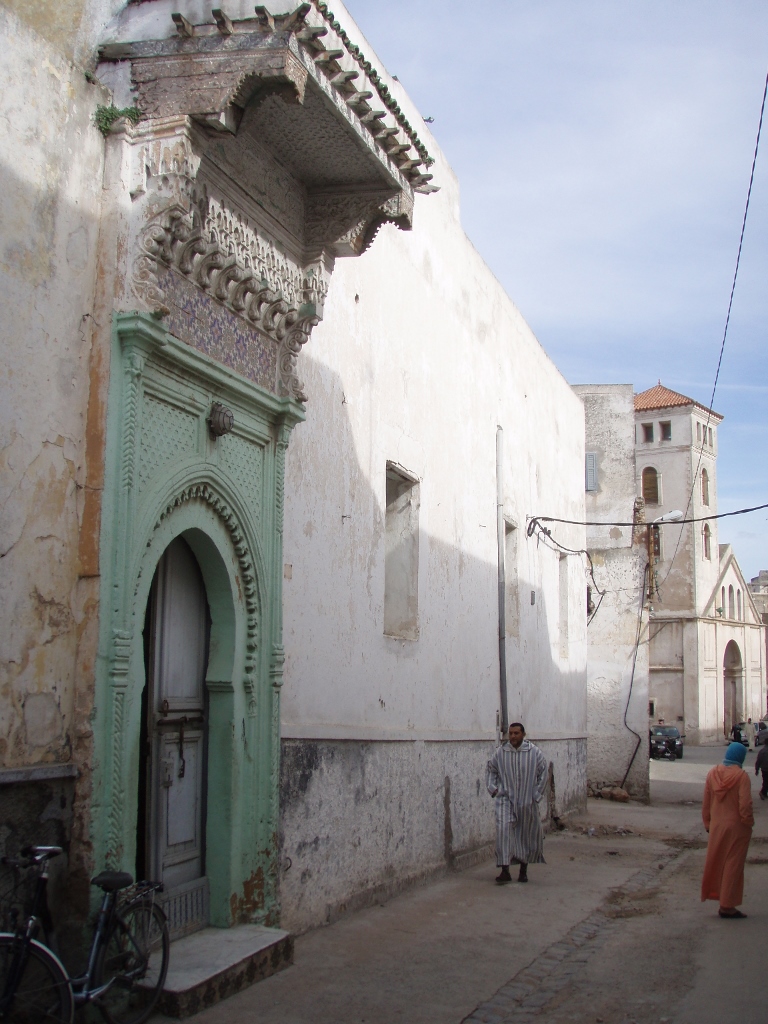 El Jadida, a detail
El Jadida, a detail
Flanking the church is a relatively large square where the Great Mosque is located. As with the Church of the Assumption, this building was also repurposed, only in the opposite direction. Once a civilian structure, a lighthouse, it was eventually transformed into a religious one – the minaret of the Great Mosque.
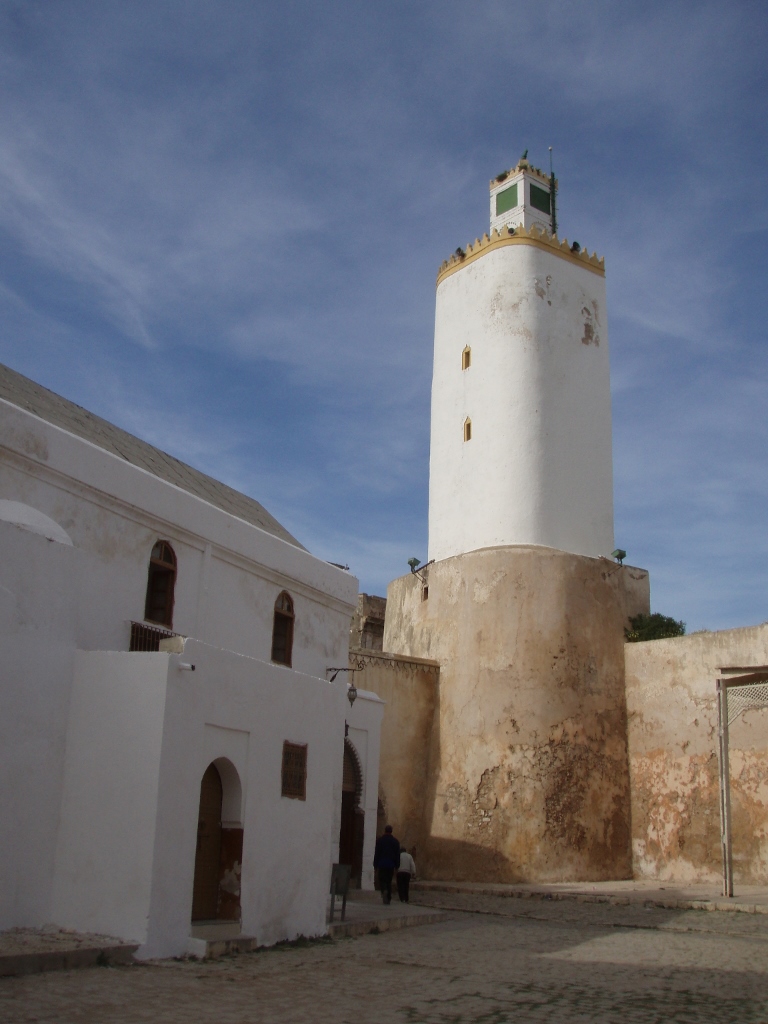 El Jadida, a detail
El Jadida, a detail
Here and along the way, I captured some more details and then I headed towards the Portuguese Cistern.
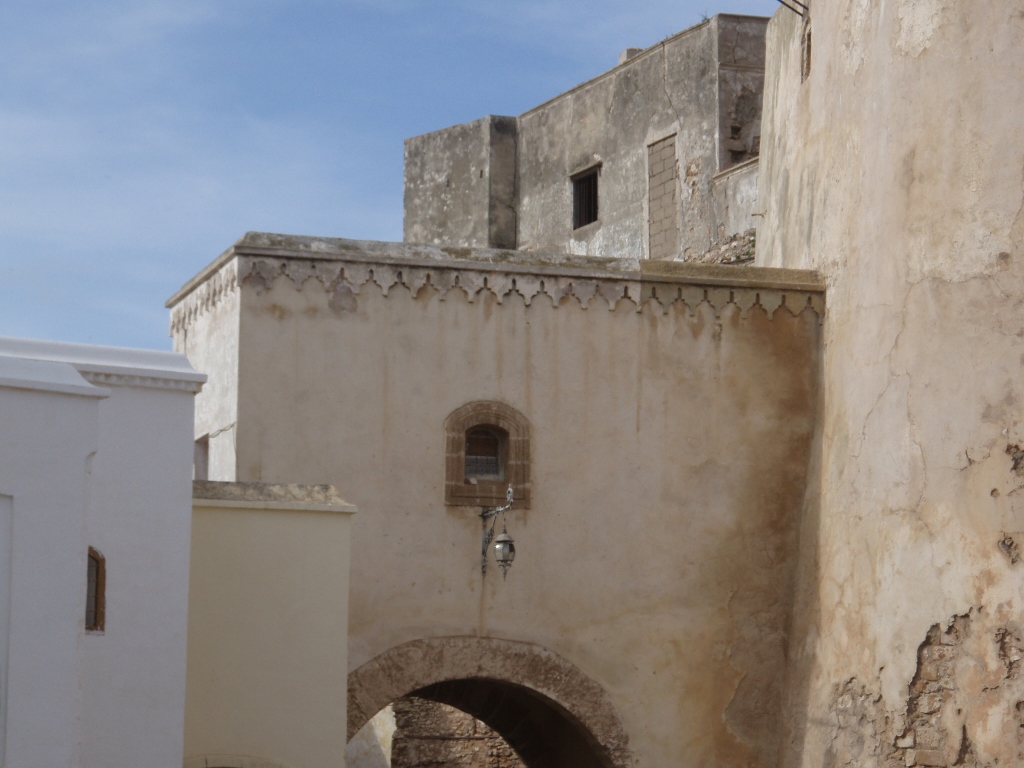 El Jadida, a detail
El Jadida, a detail
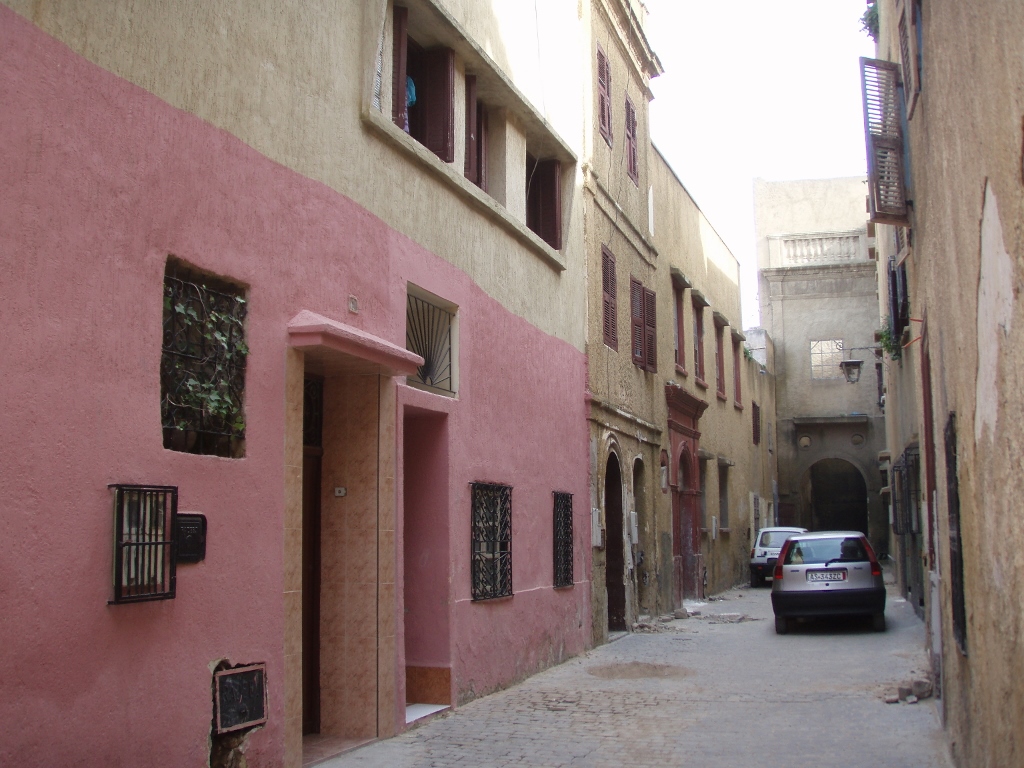 El Jadida, a detail
El Jadida, a detail
Certainly, the most interesting cultural monument in El Jadida is undoubtedly the Portuguese Cistern.
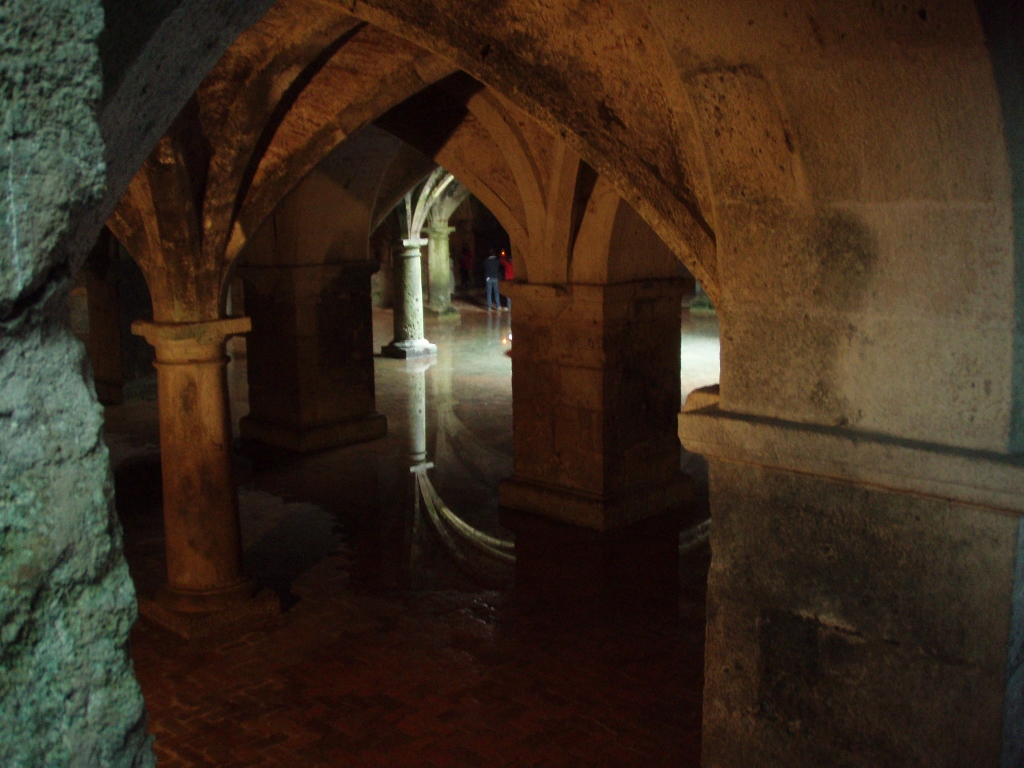 El Jadida, a detail
El Jadida, a detail
It was already the ancient Romans who built cisterns for collecting and storing water, and in the centre of Istanbul, for instance, there is also the impressive Basilica Cistern dating back to the 6th century (see: https://www.svudapodji.com/en/istanbul-4/).
However, the Portuguese built an underground water reservoir right in the middle of their fortified city of Mazagan as well and this structure has survived and remained in use to this day. Today, it is primarily a unique tourist attraction of the city.
The previously mentioned Orson Welles filmed parts of his "Othello" not only in Essaouira but also here inside the cistern.
This is entirely understandable, as the reflections of the 25 columns supporting the ceiling in the water create truly striking scenes. Additionally, there is an opening in the centre of the ceiling through which rain freely falls, collecting in the pool below.
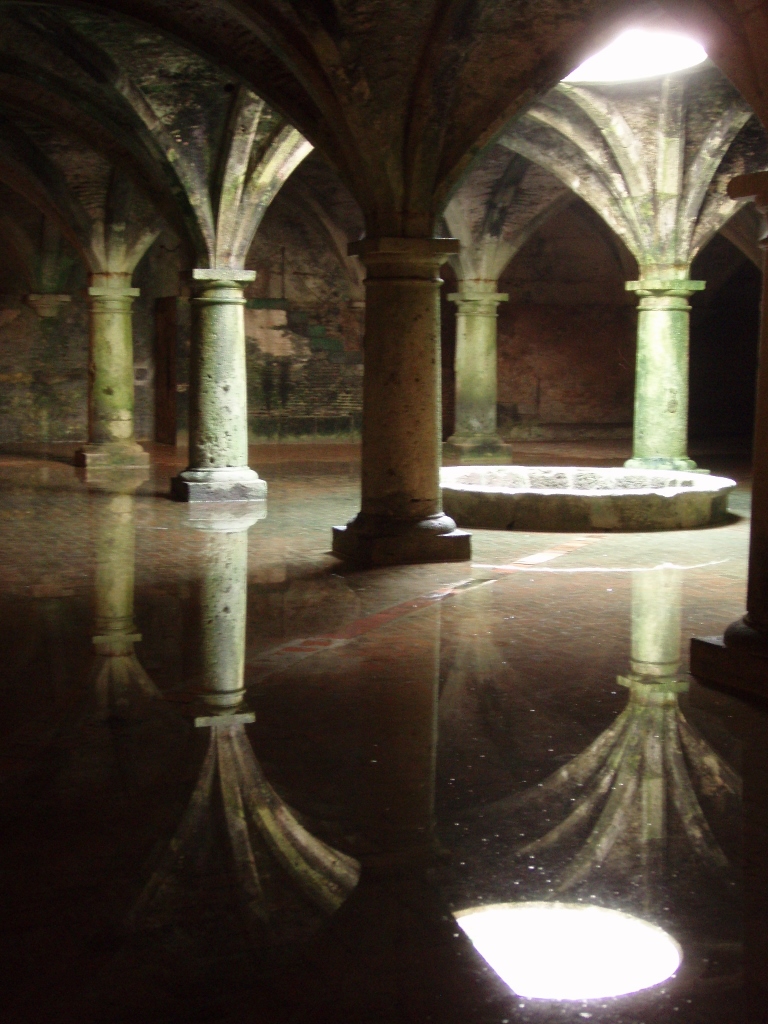 El Jadida, a detail
El Jadida, a detail
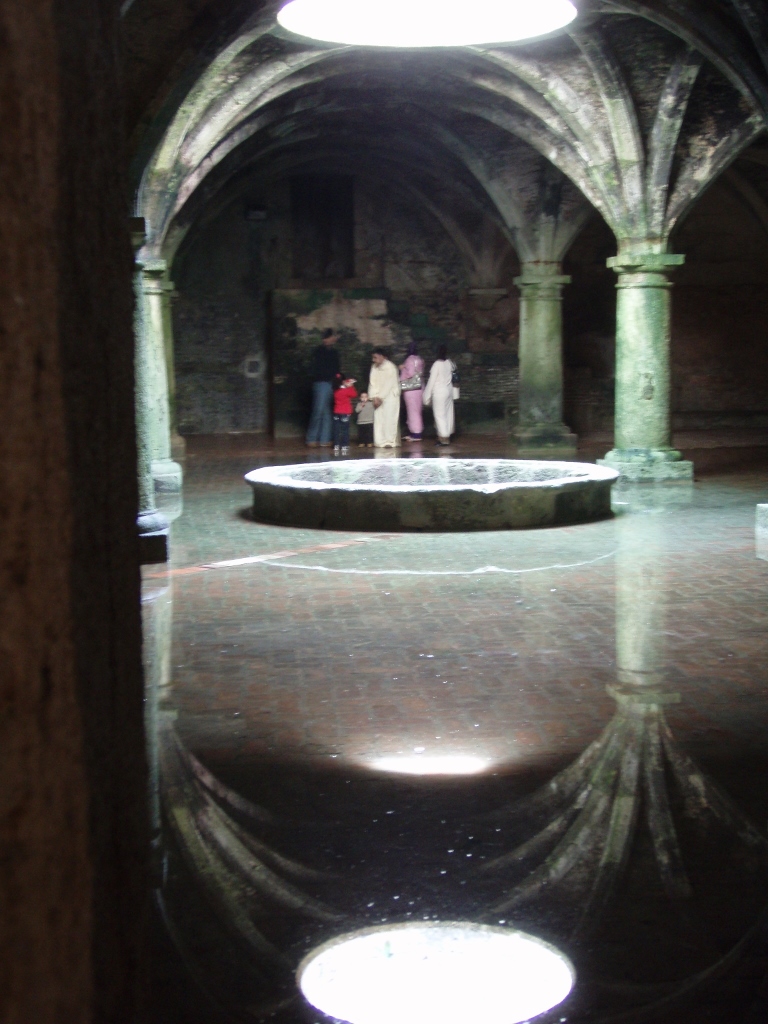 El Jadida, a detail
El Jadida, a detail
The cistern has an approximately square plan, with sides measuring between 33 and 34 m in length.
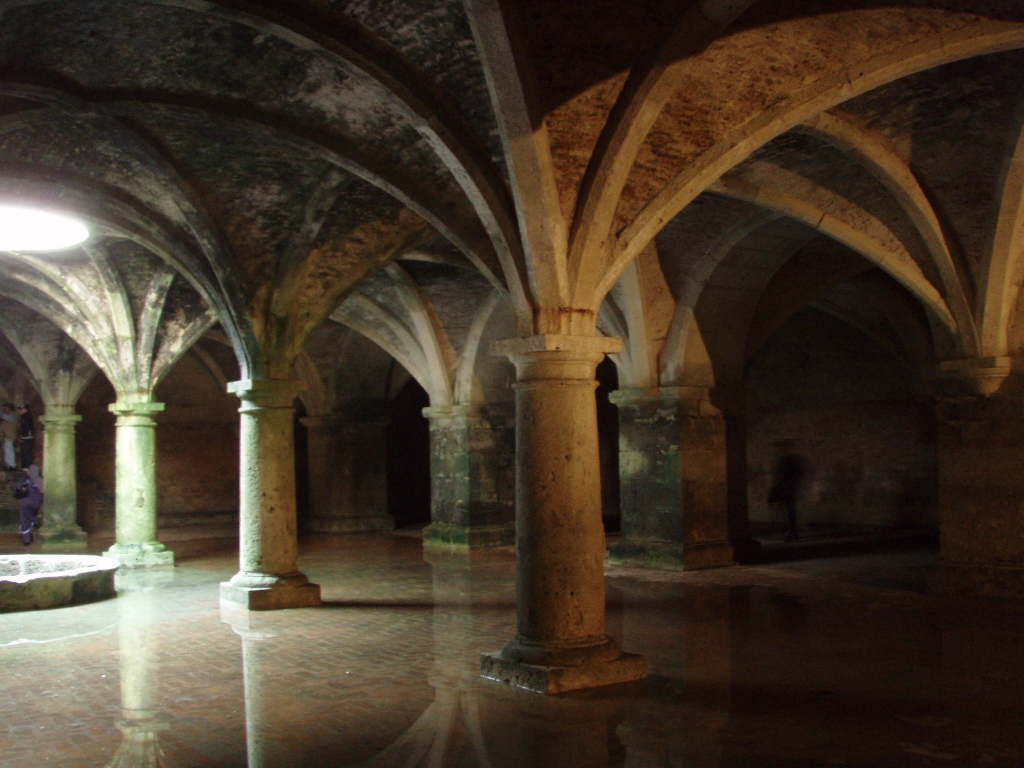 El Jadida, a detail
El Jadida, a detail
It is assumed that it originally served as an armoury or granary, but was converted into a water cistern in 1541.
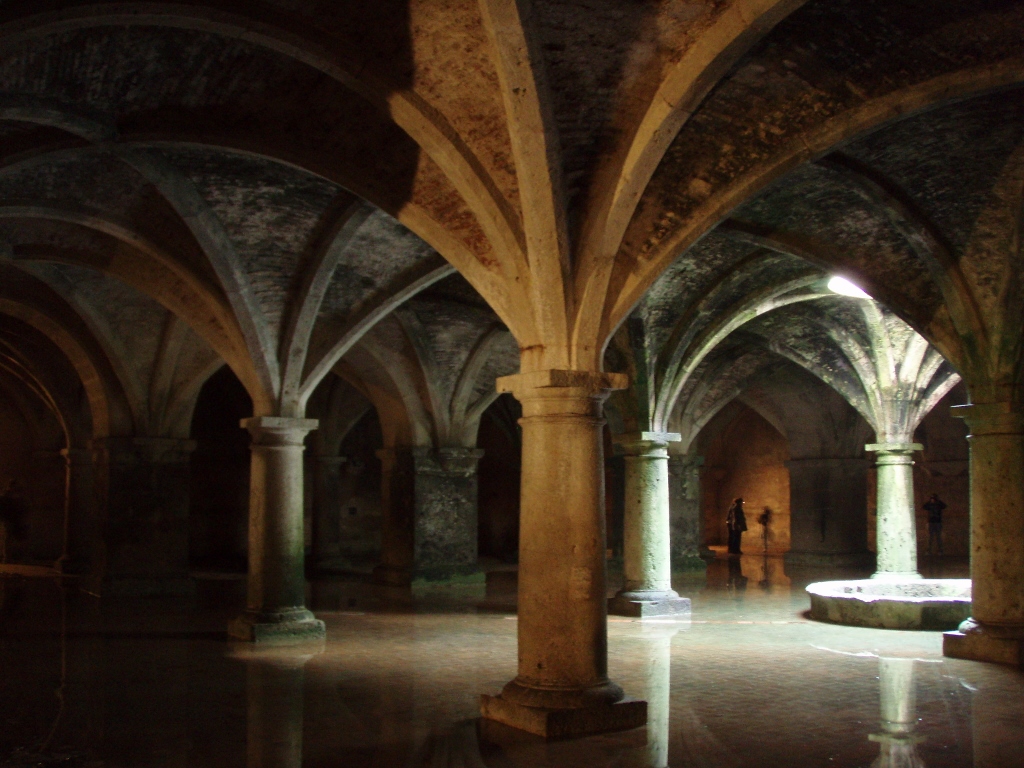 El Jadida, a detail
El Jadida, a detail
I had an interesting experience here – I suddenly became a teacher. Inside the cistern it is quite dark and back when mobile phones mostly didn’t take good photos, it was very difficult to capture the interior. I know very well one of the methods to do this, but it requires having a stable “tripod” and here the columns served that purpose for me.
A few guys were trying to photograph the cistern, but despite having a good camera, they weren’t succeeding because they were using a flash. That’s not a good solution in places like this – you capture something, but it’s far from what the human eye actually sees.
So, I explained to them that they should use the timer and find a stable support. Then the photo can turn out well. I hope they remembered the lesson.
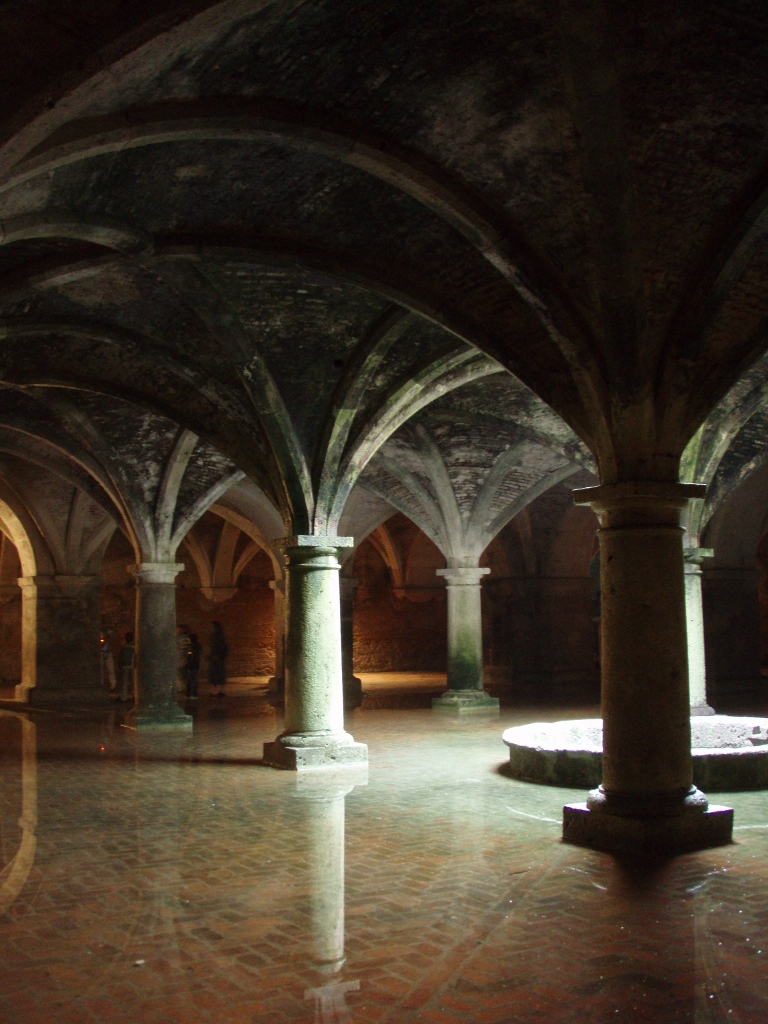 El Jadida, a detail
El Jadida, a detail
Here I finished my proper tour of historic El Jadida, then I took a leisurely stroll to the local market where I casually looked at various goods, and I also stopped at a pastry shop for freshly squeezed orange juice and a cake. The French influence can still be seen in the types of pastries made here alongside the traditional ones.
 El Jadida, a detail
El Jadida, a detail
Speaking of pastries, later I made a type of Moroccan cookie that actually appears in various versions throughout Arabic, Ottoman, and even Balkan cuisines. In Serbia (and elsewhere in the Balkans), we call them gurabije and make them in “our” way, but these almond-based cookies in Morocco are called ghriba. They are most often served with mint tea, which is extremely popular throughout the Maghreb region of northwest Africa.
 My version of chocolate ghriba
My version of chocolate ghriba
Here is the recipe:
CHOCOLATE GHRIBA
- 200g cooking chocolate
- 50g butter
- 100g sugar
- 2 eggs
- 1 packet of vanilla sugar
- 1/2 teaspoon almond extract
- 150g ground almonds
- 100g all purpose flour
- 1/2 packet of baking powder
- a pinch of salt
- about 100-150g powdered sugar
Melt and thoroughly combine the chocolate and butter. Stir in the sugar, eggs, vanilla sugar, and almond extract. Then carefully mix in the ground almonds, flour, baking powder, and salt. Cover and place in the refrigerator to rest for at least a few hours, or overnight.
Form balls from the dough, then roll each one in powdered sugar. Place the balls on a baking sheet lined with parchment paper and gently press them to shape into cookies. Also, make sure to leave enough space between the balls/cookies as they will expand.
Bake at 180 degrees Celsius for about 12–15 minutes.
After a pleasant break for juice and cake in El Jadida, I continued walking through the city towards the coach station. Contemporary El Jadida is a very nice place, too.
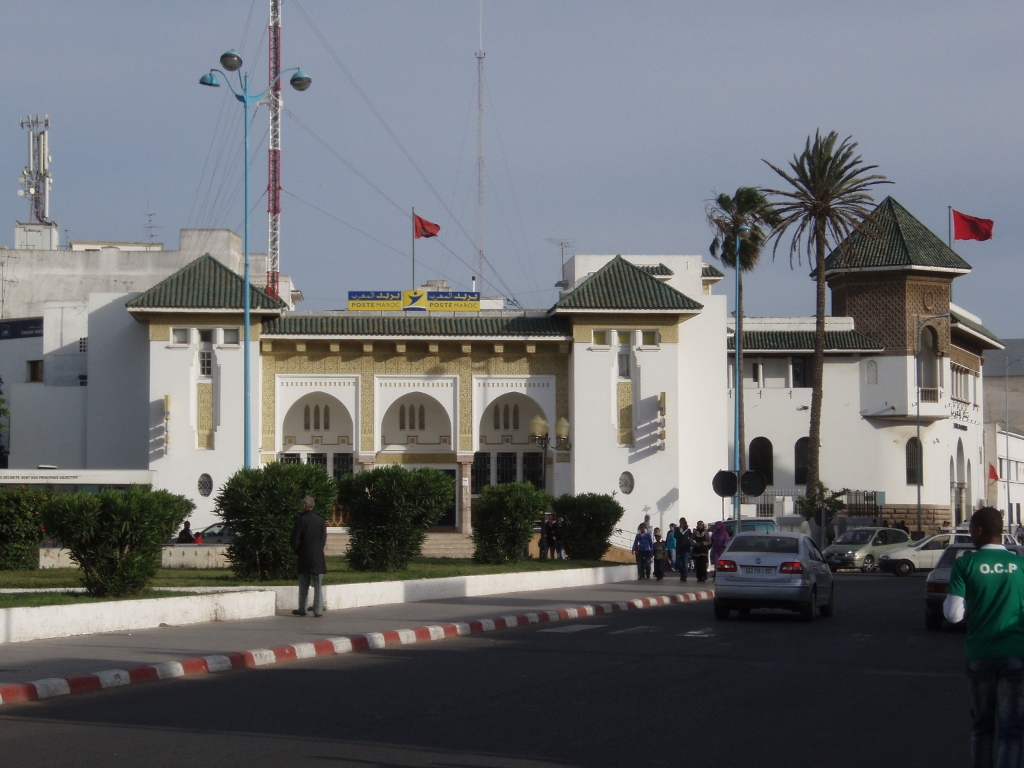 El Jadida, a detail
El Jadida, a detail
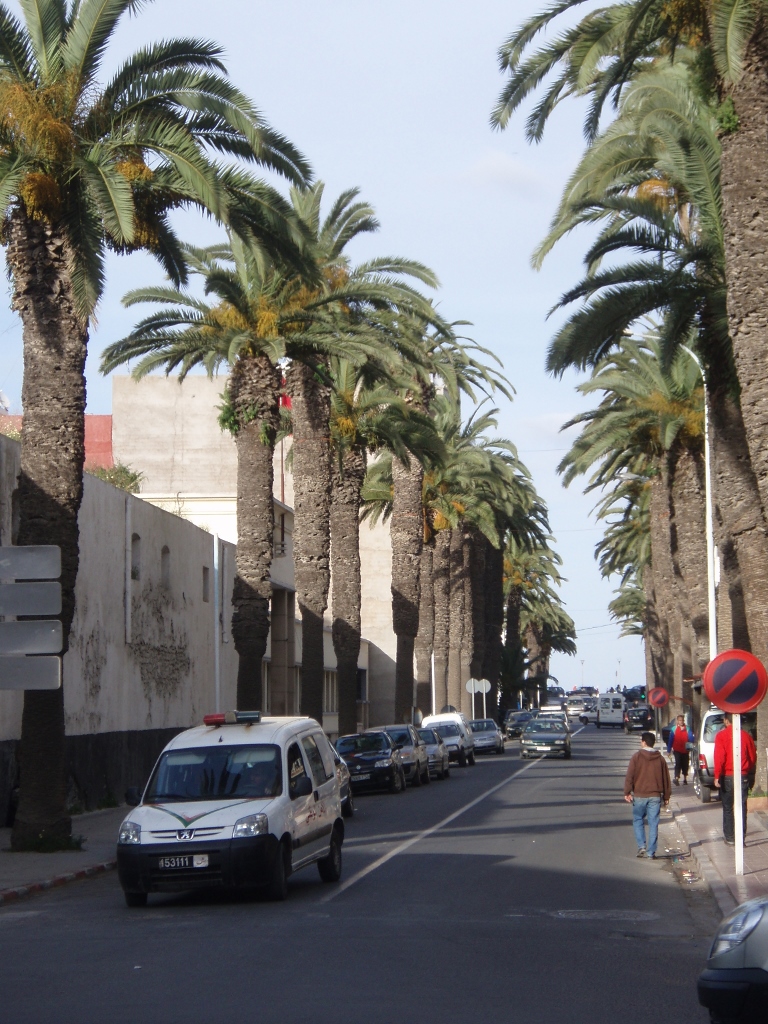 El Jadida, a detail
El Jadida, a detail
Since I arrived at the station earlier than the scheduled departure of the intercity coach, I had just enough time to enjoy a cup of the very popular mint tea. I like and often drink mint tea at home too, but without sugar, so that’s how I drank it in Morocco as well.
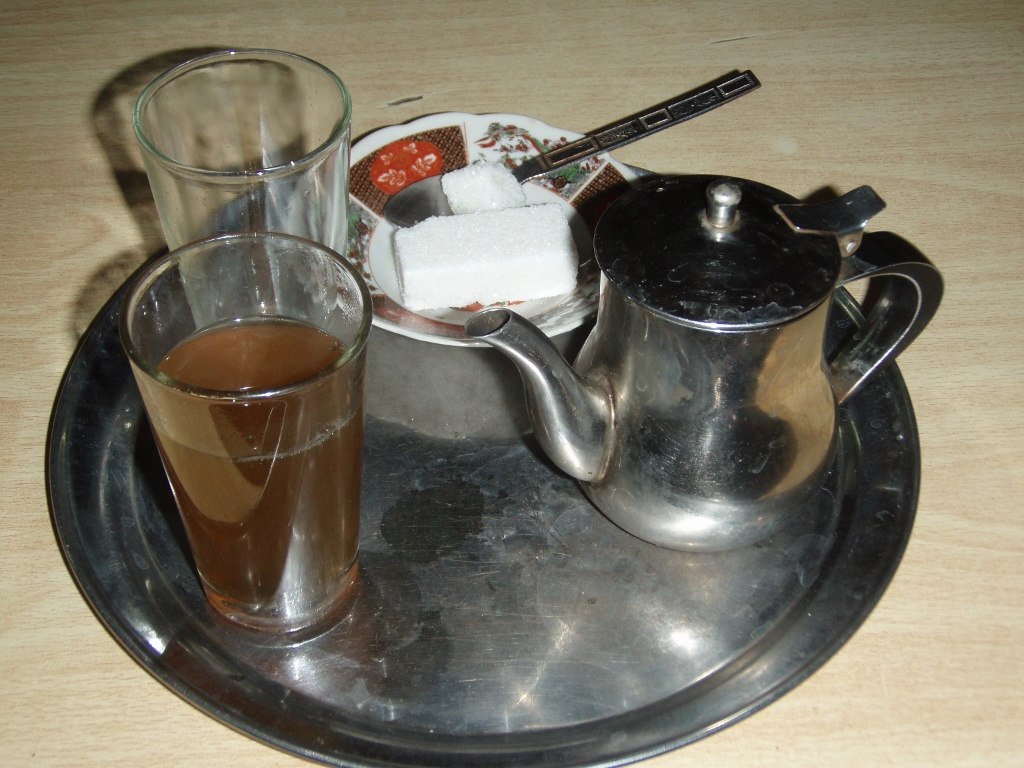 El Jadida, a detail
El Jadida, a detail
The next day, I wasn’t in any hurry at all. I planned to leave for Casablanca by coach around noon, so I had free time before that. I spent it by taking another walk to the old part of Safi and the medina, and I especially enjoyed that the day was perfect – sunny and windless.
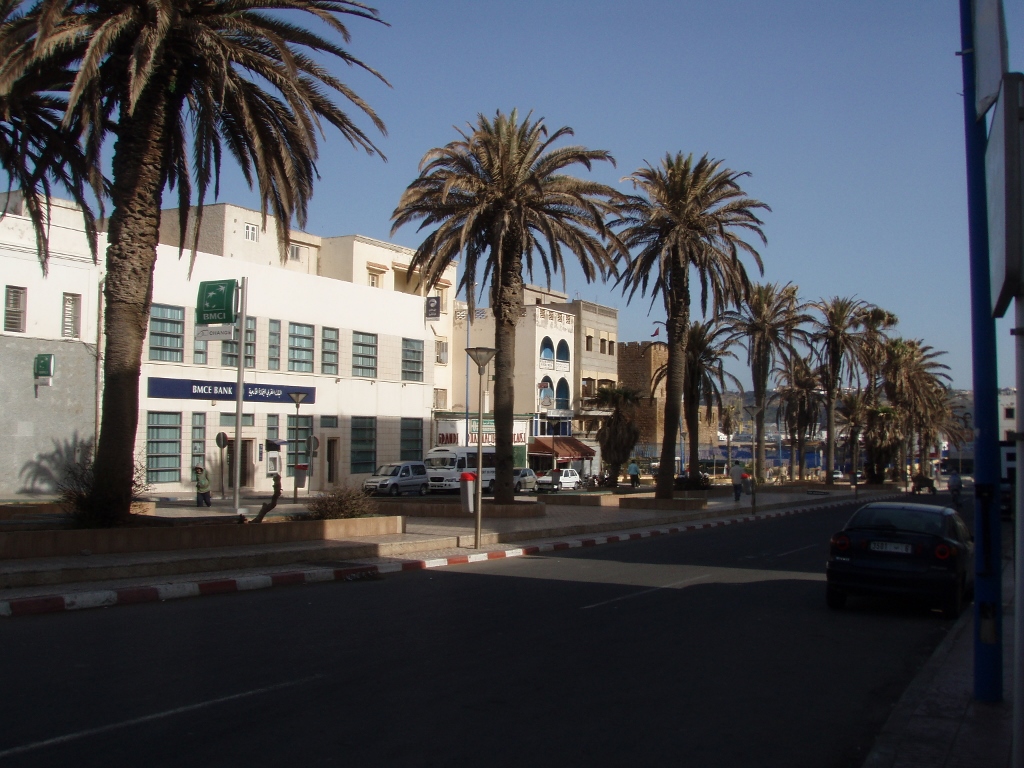 Safi, a detail
Safi, a detail
I went down to the coast and there once again I passed by Casr al-Bahr, near which there is another small, but very picturesque mausoleum.
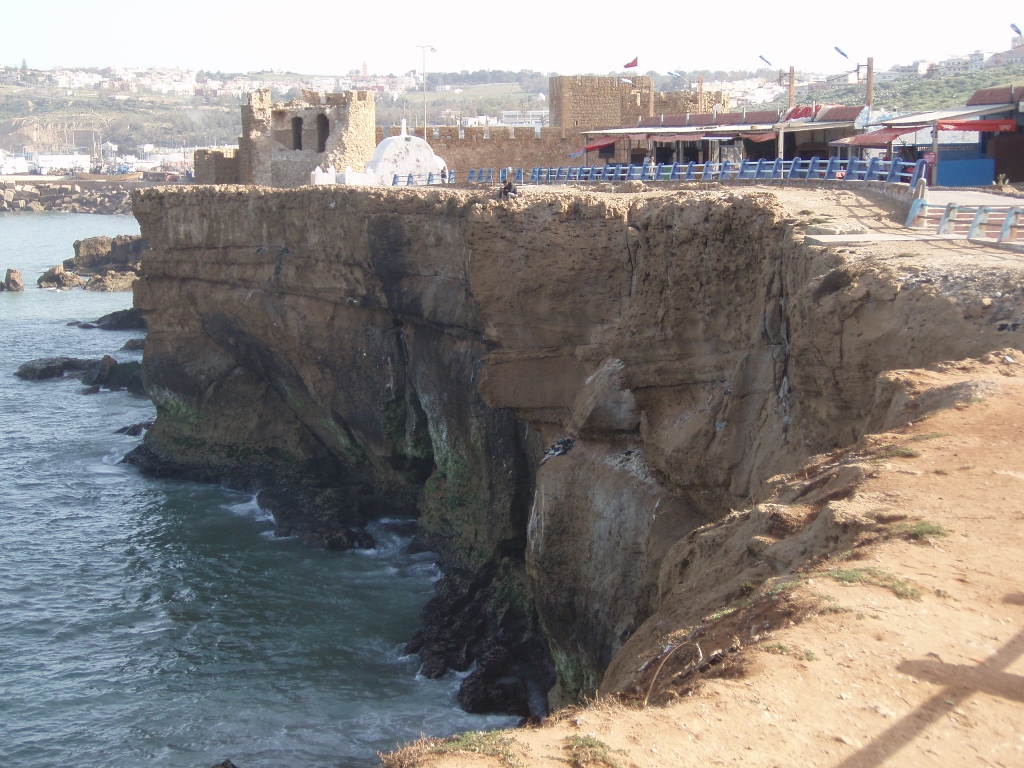 Safi, a detail
Safi, a detail
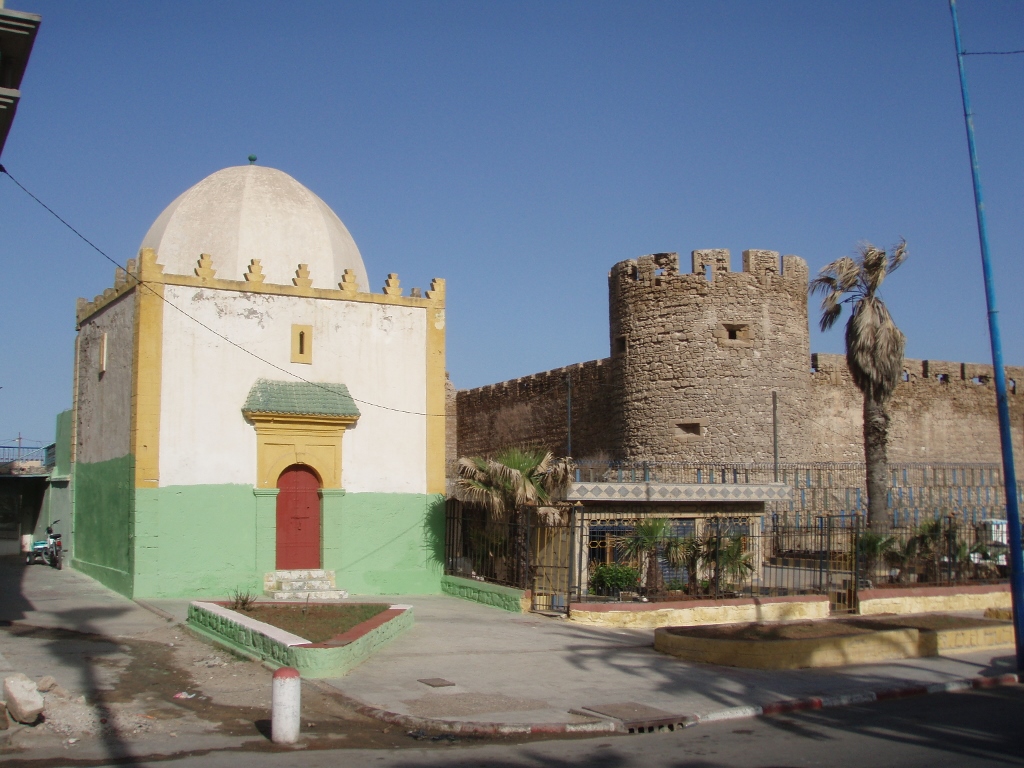 Safi, a detail
Safi, a detail
A little further on, I reached the Bab El Maasra gate, which leads into the medina, as well as the Sidi Boudhab Mausoleum.
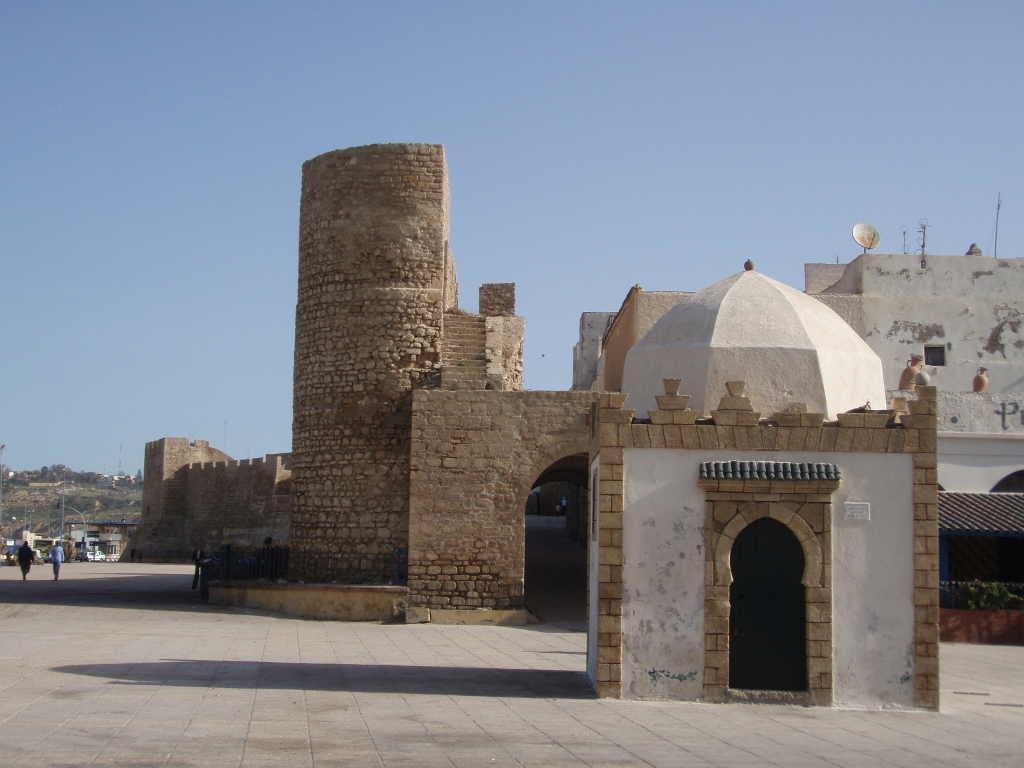 Safi, a detail
Safi, a detail
That day, the spice shops interested me much more than the pottery souq because I intended to buy something. I knew I would visit the souqs in Casablanca as well, but I wanted to make a purchase here since I had plenty of time and knew it wouldn’t be difficult for me to carry it.
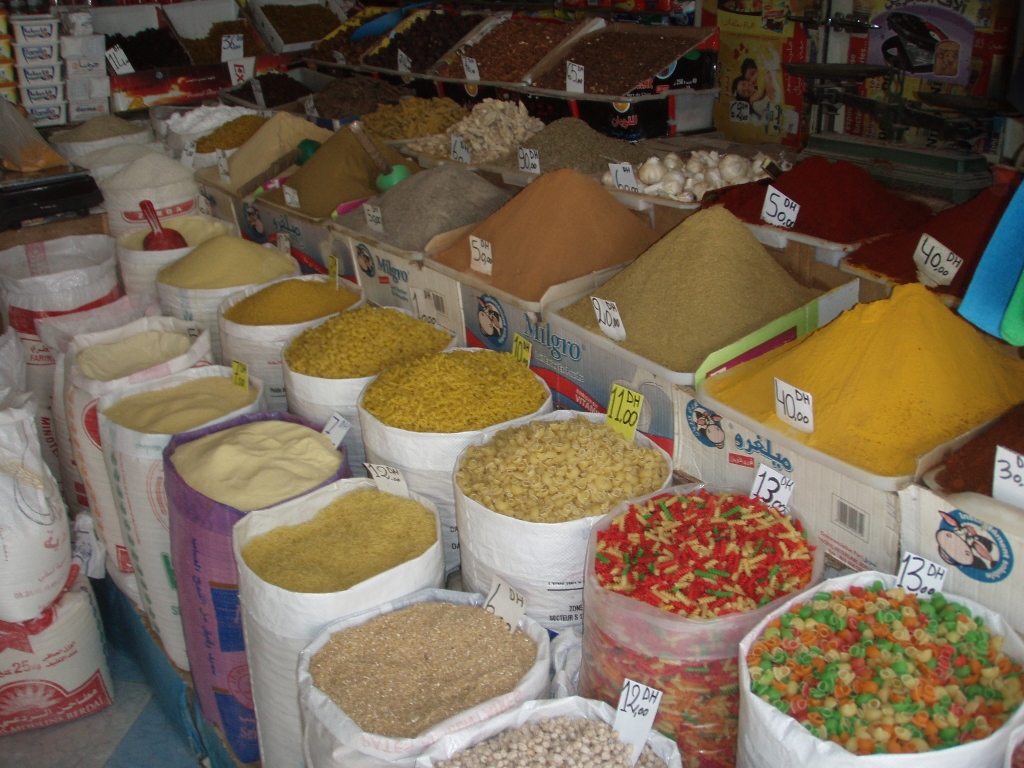 Safi, a detail
Safi, a detail
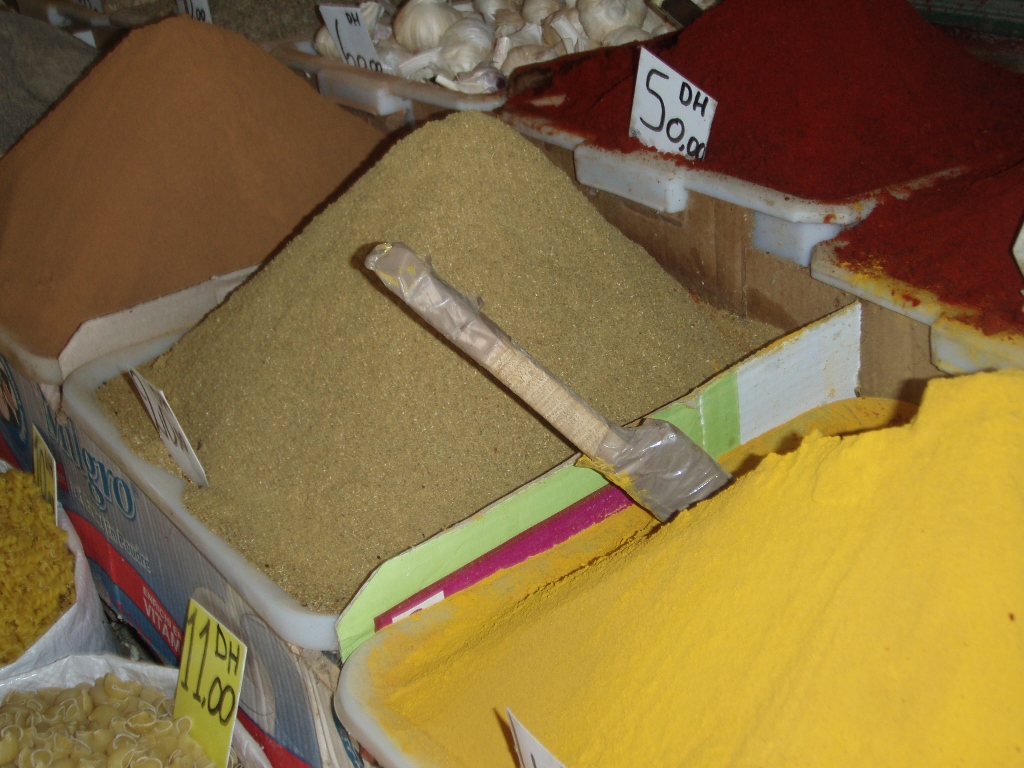 Safi, a detail
Safi, a detail
 Safi, a detail
Safi, a detail
Afterwards, I continued strolling near the walls and through the medina in Safi, truly enjoying the beautiful sights.
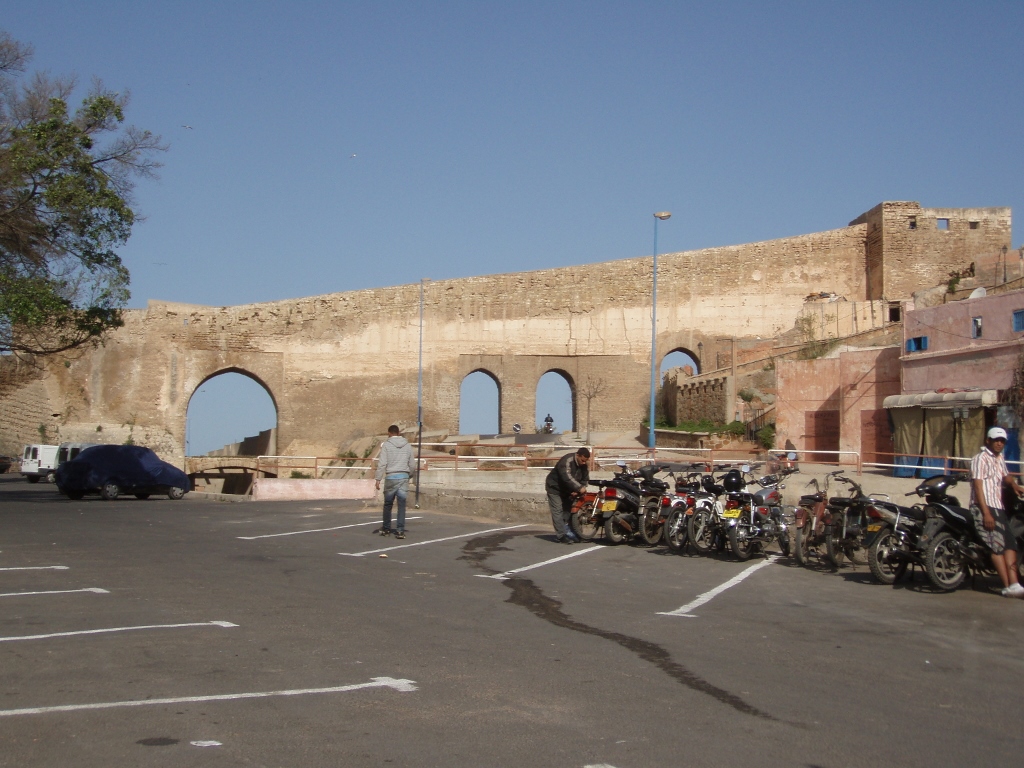 Safi, a detail
Safi, a detail
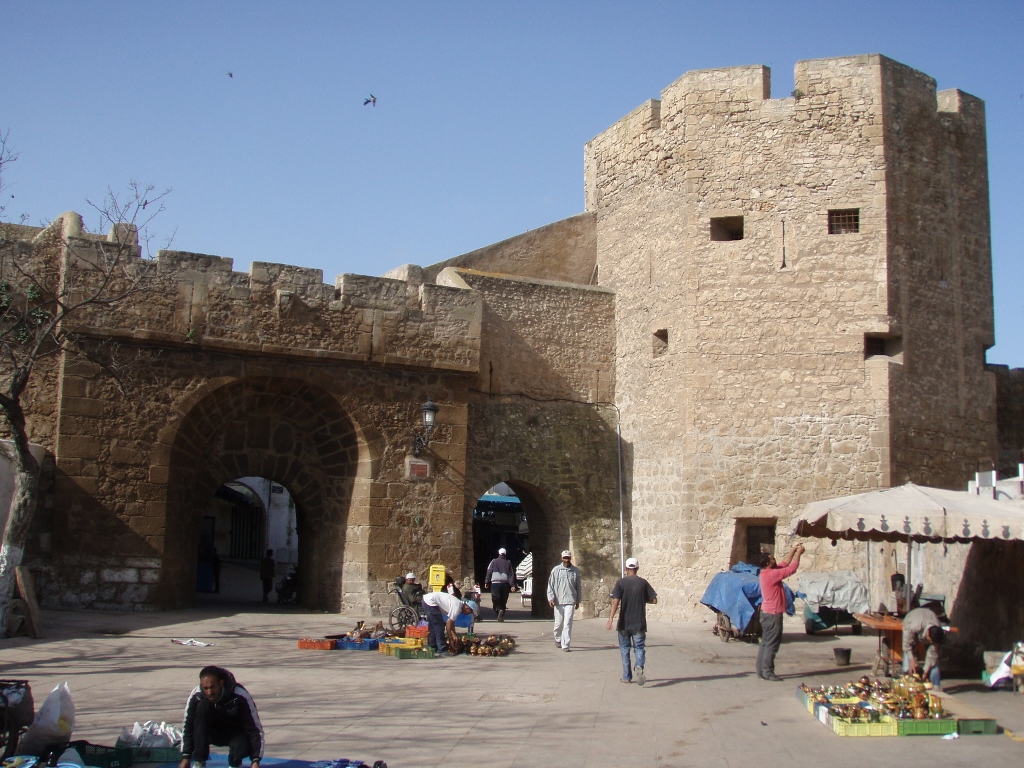 Safi, a detail
Safi, a detail
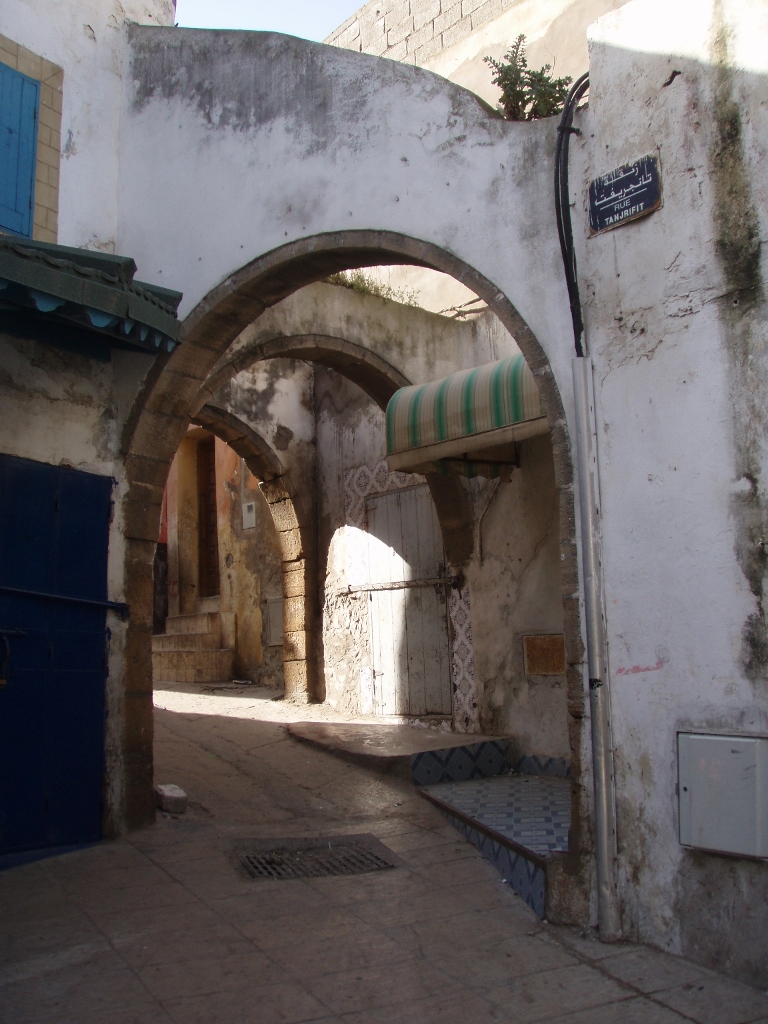 Safi, a detail
Safi, a detail
Still, at some point, I had to head back to the hotel where I just packed a bit more in my room and then I walked to the nearby coach station.
The distance from Safi to Casablanca is about 250 km, but this journey didn’t take as long as travels in northern and eastern Morocco – partly because of the excellent coach I took here, and partly because there were fewer stops. In any case, I arrived in Casablanca in the afternoon and went to the same hotel where I had stayed at the very beginning of the trip. I left my things in the room and went out for a walk.
I found it interesting to observe my own feelings. Suddenly, I felt joy about returning, and that joy grew even more when I stepped out onto the street. Somehow, I was seeing and experiencing Casablanca with completely different eyes and that made me happy: now I wasn’t sick, I wasn’t tired, and my luggage was where it should be – in the room. Besides that, I felt much more relaxed: I had “rested” in my own way for two and a half weeks, and I had gotten used to the country, the people, and the customs. A completely different feeling compared to how I felt upon my initial arrival. I simply thought that I could stay here even a little longer.
More about what I did in Casablanca at the end of my 2010 Morocco trip will come in the next part of the travelogue, but for now, here’s again a geographic map showing all the places I visited during this journey.